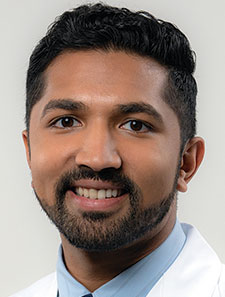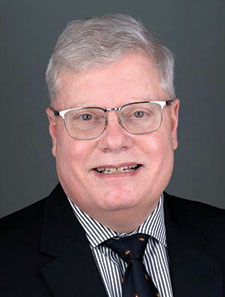A Resident’s Perspective
“Convenience and efficiency are the biggest benefits of using technology as a resident,” according to Ajay Nathan, MD, a PGY2 otolaryngology resident at the University of Connecticut School of Medicine in Farmington. “In college, I spent a lot of time reading textbooks and taking notes. As a busy resident, this is not possible, and you must find ways to get learning in where you can because finding a dedicated time to study can be difficult. Often, non-clinical learning happens in short breaks between surgical cases or at the end of a long day.”
Explore This Issue
April 2025“One tool that I use is Google’s NotebookLM, which is an AI tool that generates summaries and answers based on materials that I upload. I put in digital versions of ENT textbooks as the source material, and I’m able to quickly review information based on questions I ask the tool. This makes studying really easy. For example, I can ask, ‘What is the relevant surgical anatomy to know for my case tomorrow?’
“There are plenty of apps available as well, which can help serve as a quick reference guide. These can be great for studying in five- or ten-minute intervals while on the go. As a medical student, I would often watch lecture recordings at two times the speed after reviewing relevant materials beforehand. I found that this was the best way to absorb the material.
“My medical school has transitioned out of traditional lectures altogether and has moved toward flipped classrooms where you watch videos beforehand and then attend group discussion sessions. I think this learning style will quickly take over in all kinds of medical education. Studies are not only showing that this is a more effective form of pedagogy but that it also helps to better teach the social and communicative aspects of medicine that go beyond the textbook.
“Medical schools are definitely adapting to the use of new technologies. One way I see this moving forward is by increasing the use of simulation, which can be such a powerful tool to help bridge the clinical setting to the classroom and apply learning. Virtual reality, 3D printing for accurate surgical models, and AI-enhanced experiential learning models are all ways I expect to see this applied through simulation.”
Medical School Deans’ Perspectives
Jeffrey Bumpous, MD, is the executive vice president for health affairs and dean of the University of Louisville School of Medicine in Kentucky, where he also serves as a professor of otolaryngology–head and neck surgery.
“We have geared up our technology and support for students. Everyone has technology that they use in M1 through their last PGY of training. Libraries have fundamentally changed, and those physical facilities are enhanced study spaces, archives, and technical support centers for learning and research. Artificial intelligence (generative AI and other enhanced computing formats) is increasingly used in educational, research, and clinical situations.
“The space and the context of the academic medical center and medical school are changing, but in my opinion remain relevant. I do not think you can become a critically thinking and discerning physician in a fully online program at this point. I also think that we must not forget that human interaction is, in fact, therapeutic; so, the threat on the horizon in my mind for medicine is that if we become too remote, we may fail to be relevant.
“It is my sincere aspiration that we will continue to emphasize critical thinking skills, ethics, and professionalism and that we will not forget the important therapeutic effect of human relationships; they are not mutually exclusive.”
Carol R. Bradford, MD, MS, is the dean of the college of medicine and vice president for health sciences at the Wexner Medical Center, both at The Ohio State University in Columbus, where she also serves as a professor of otolaryngology–head and neck surgery.
“Our health professions students are typically early adopters of AI and software to supplement and facilitate their learning. The frequency is increasing among students, while faculty take more time to assess and embrace such technologies.
“The days of all-day in-person classes are gone; however, classroom work is not. Classrooms are now used to facilitate the application of knowledge to the clinical environment rather than the direct transfer of medical knowledge, which students gain more effectively through e-learning and videos.
“Medical schools and program directors are adapting to this type of learner through essential faculty development. Faculty and staff need to understand the available technologies and how to best guide students in their use. This proactive approach ensures that both students and educators can fully benefit from these advancements in technology.”
Joseph E. Kerschner, MD, is an emeritus dean of the school of medicine at the Medical College of Wisconsin, where he serves as a professor of otolaryngology and communication sciences, and microbiology and immunology.
“More and more medical schools are using small group teaching with case-based learning. So, students may be in person all day but not in large lecture halls. Earlier clinical training is also employed at almost all medical schools. For those sections of the curricula that do have lectures, especially since the pandemic, virtually all schools provide recorded or digital options for students. Most students are familiar with and use AI and LLMs. Most medical schools are encouraging students to understand these tools and incorporate them as part of their learning and education.
“Program directors, I believe, would say that the medical students that match today are, in many ways, better prepared for medicine that has a knowledge that doubles about every 20-30 days compared to about every five years 40 years ago.
“A difficulty is that it is certainly more expensive to provide medical education that is more personalized and in smaller groups than with large lectures. So, the cost to the medical school to train a physician has increased; however, the pros include more efficient learning, better recall and impact in smaller groups, earlier clinical exposure (the reason most of us chose to be physicians), and the use of technology to enhance and improve education—something that has happened for centuries, and this is just the latest version.”


Leave a Reply